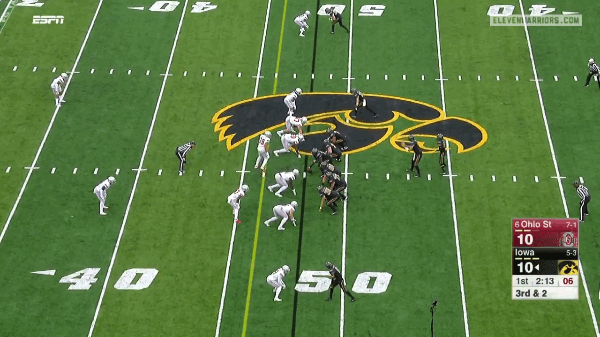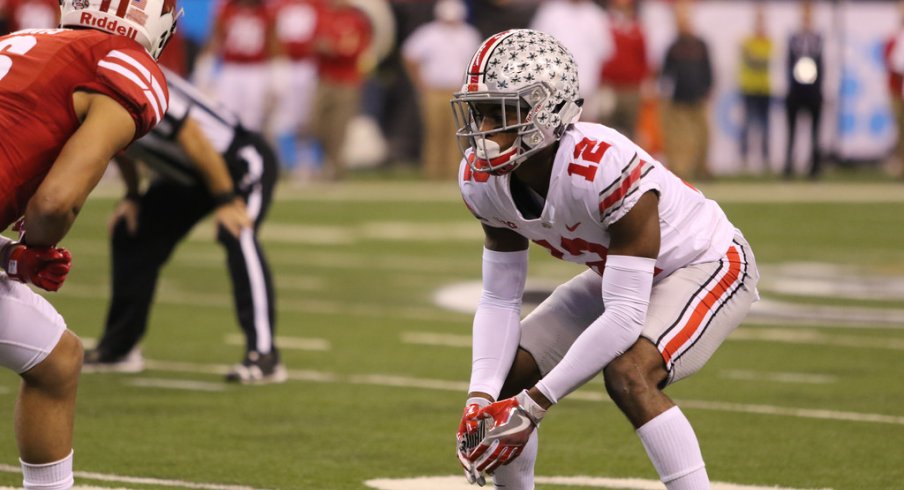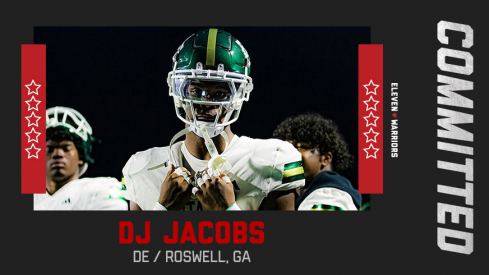Since assuming duties as Ohio State's defensive coordinator, Greg Schiano has found tremendous success. Though he walked into as good a situation as any coach in his position could desire, with a roster stocked full of blue-chip talent and position coaches with decades of experience, the former NFL head coach has kept the Buckeye defense among the nation's elite.
It would've been very easy for the new leader of the Silver Bullets to have simply kept the system of his predecessor in place, as the Buckeyes had become one of college football's top units under Chris Ash. Not only had they returned to the lofty heights expected of the team from Columbus, Ash's defense helped win the school's first national championship in over a decade, bringing home the first College Football Playoff trophy.
But upon his arrival at the Woody Hayes Athletic Center, Schiano saw a different way forward. Likely due to the talent present in his new secondary, Schiano opted not to continue his team's reliance on the pattern-matching techniques found in Ash's Quarters scheme, running man-to-man coverage almost exclusively in the opener against Bowling Green, despite returning only one starter from the year prior.
| Year | Yards Allowed / Attempt | National Rank |
|---|---|---|
| 2012 | 6.3 | 23rd |
| 2013 | 7.0 | 57th |
| 2014 | 6.1 | 12th |
| 2015 | 5.8 | 8th |
| 2016 | 5.6 | 1st |
| 2017 | 6.1 | 10th |
Despite its simplicity, few modern defenses prefer to use man-coverage as often as the Buckeyes have in the past two seasons, due mainly to the simple fact that it's difficult to find enough qualified defensive backs to put on the field against the three and four-receiver looks that are so prevalent in today's game. Of course, Schiano will see his fourth defensive back in the past two years get selected in the first round of the NFL draft when Denzel Ward's name is inevitably called, meaning the Ohio State secondary was always destined to look different than their contemporaries.
Conversely, as we've spoken about previously in this space, programs with similar talent like Alabama, Clemson, and Georgia have opted to use their stocked cupboards to get more complex with their coverage concepts and techniques in recent years, operating with a level of diversity in scheme often only seen in the NFL. Yet instead of adding pages to the playbook, Schiano has largely removed them, relying instead on the simplicity of his Cover-1 system.
"Our job is just put them in a position to go play as hard as they can," Schiano said early in the 2016 season. "If we can simplify the scheme and still get done what we need to get done, that's our job."
This simplicity allows players like Denzel Ward and Jordan Fuller to step into starting roles and shine almost immediately, as both did last fall. But it also allows opponents to manipulate the defense, putting defenders in conflict or isolating the rare matchup where the Buckeyes may not have a personnel advantage.
A Schiano returns for a third year with two returning corners in Damon Arnette and Kendall Sheffield that finished the year strong against the USC passing attack, there's little reason to expect Ohio State to employ man-coverage less often. With that in mind, let's take a deeper dive into what this philosophy brings to the table.
PROs
While they occasionally showed Cover-0 behind a blitz and Man-2 coverage on long third downs, the Buckeyes' preferred method of playing man is from a Cover-1 scheme in which a safety roams the middle of the field, reading the eyes of the quarterback behind five defenders locked in one-on-one battles just as you might see in your annual backyard turkey bowl. While there is quite a bit of additional nuance to this seemingly simple play-call, these defenders will often try to maintain outside leverage on their receiver, funneling them inside to the lurking free safety or the "rat" or "robber" linebacker that looks to disrupt any crossing patterns underneath.
Of course, the benefit to such a scheme is the simple ability for each defender to identify their coverage responsibility before the snap and focus on executing it without worrying about any additional movement.
As seen in the example above, the linebacker travels with the running back on his flare motion out of the backfield while the robber takes away the inside route of the slot receiver to that side, helping the strong safety playing in "off" coverage. The back seven have done their job, leaving the front four to eventually collapse the pocket and force the QB to throw the ball away, creating an ideal result for the defense.
But playing any coverage is about more than just pass defense. While worrying about getting beat over the top is certainly a priority, where each player lines up plays a major factor in a defense's ability to stop the run, meaning the two must go hand-in-hand.
One of the biggest factors in playing Cover-1 is the ability to get all three linebackers to cover run gaps without worry of covering an outside receiver as they would in a pattern-match or zone scheme. Seeing such a philosophy from Schiano should be no surprise, as he cut his teeth in Penn State's old school 1-high, Cover-3 zone that allowed the strong safety to effectively act as a fourth linebacker to stop the run against two-back sets.
While spread-to-run offenses like the Buckeyes' own may be concerned with getting an arithmetic advantage in the box, leaving no one unblocked to tackle the ball-carrier, the defense is simply concerned with the number of gaps it must fill. With five linemen and a tight end or fullback, the four defensive linemen and three linebackers can account for each gap adequately.
But perhaps more importantly in today's game, man-coverage takes away the advantage gained by run-pass options (RPOs), as there is no defender that can be put in conflict between his run and pass responsibilities.
As seen above, the quarterback reads the movement of the defender covering the bubble screen, which is the strong safety in this instance. But because that defender immediately closes on the route, the quarterback is forced to give it to the running back with nowhere to go.
Of course, there are still ways to beat man-coverage with RPOs, such as using the running back as a blocker and the quarterback as a runner, thus creating an additional gap that isn't defended. But overall, this coverage technique is a simple, straightforward way for a defense to stymie the latest trend in football without having to make countless adjustments or watch hours of film.
Since switching primarily to man-coverage, the average yards allowed per passing attempt by Ohio State has remained on par with the results seen from Ash and his system. But the average yards allowed per rushing attempt has improved mightily, going from 3.95 (43rd nationally) in 2014 to 3.38 (14th) in 2015, 3.35 (12th) in 2016, and all the way down to 2.94 (4th) in 2017.
Cons
By now you may be wondering either: 1) why every team with the personnel to do so doesn't just rely on man-coverage or 2) how this seemingly perfect scheme was thrashed by both Oklahoma and Iowa last fall. Unfortunately, both questions have largely the same answers.
After the Buckeyes stormed into Norman in 2016 and shut down the Sooners' high-powered offense, leaving Baker Mayfield to scramble for his life most of that evening, head coach and play-caller Lincoln Riley used the defense's tactics against them in the rematch one year later. Following a first quarter in which he probed the defense with basic runs and pass patterns to see if Schiano's game plan had changed, Riley unleashed a bevy of play-action passes that didn't look to catch the secondary flat-footed, but rather put the linebackers in conflict.
Knowing the outside receivers would be blanketed throughout the evening, the Sooners not only felt they had better personnel matchups with talented tight ends Mark Andrews and Dimitri Flowers running downfield against linebackers, they knew the Buckeyes would look to stop the run first. Not only did Riley fake the handoff, he threw off the linebackers' basic run/pass reads by appearing to pull linemen as if they were running a counter scheme, the primary run in their system.
Flowers finished the game with seven catches for 98 yards and a touchdown as the Sooners tallied 490 yards of offense in their upset victory on the road, 386 of which came through the air. But not all of those passing yards came off play-action, either.
For years, offenses have stymied man-coverage by bunching receivers and combining routes that set a natural "pick" on a defender, forcing him to go around other people to get to his assignment and creating enough separation to complete an easy pass. Though they no longer had anyone like Heisman candidate Dede Westbrook lined up outside, the Sooners still had plenty of speedy playmakers that could punish the Buckeye defense with the ball in their hands.
While route concepts like Drive will work against both man and zone coverages, Riley added some extra wrinkles, like releasing the running back into a pass pattern just in front of the linebackers to create another pick.
But though Ohio State didn't face a play-caller quite as creative as Riley throughout the remainder of the 2017 campaign, similar tactics proved difficult to stop as the season went on. Iowa used play-action and natural picks to free up running backs and tight ends all afternoon in their blowout upset of the Buckeyes, attacking the linebackers with seemingly every known tactic to beat man-coverage.

While relying heavily on Cover-1 simplifies things for Schiano's defense, it can also leave them exposed. Even the most man-heavy schemes at the next level don't run it as often as the Buckeyes, as the Tennessee Titans lead the league in 2016 by running man-coverage on 49.6% of their snaps according to Pro Football Focus.
After the loss in Iowa City, though, Schiano began incorporating more of the Quarters scheme on early downs, hoping to negate the overwhelming tendencies that were showing up on the scouting reports. The approach worked, as the Silver Bullets returned to form, keeping each of their four remaining conference opponents under 300 yards of offense.
Despite having to replace six starters and a cornerbacks coach, the Ohio State defense will undoubtedly return with a similar approach in 2018. But much as even the best major league pitchers can't simply throw their fastball on every pitch, Schiano and the Buckeyes must find a secondary coverage with which they are just as comfortable to keep opponents off-balance.



